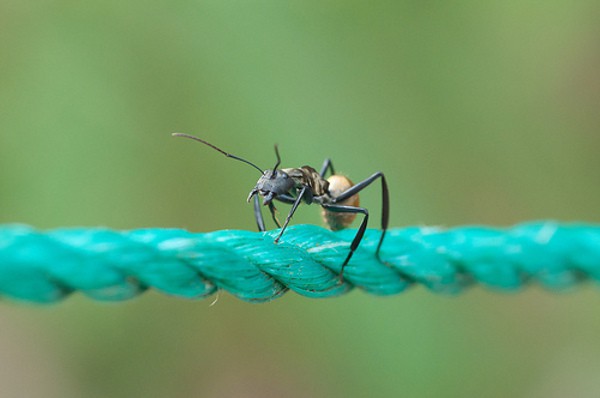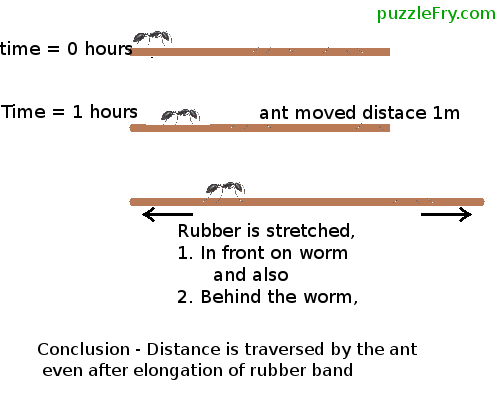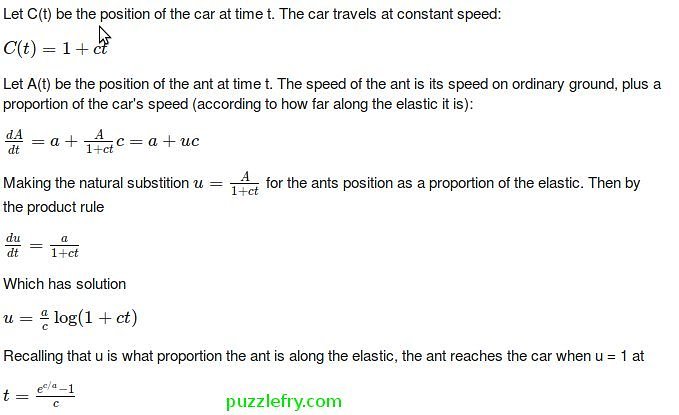The worm and the rubber band
A rubber band (well, a rubber string, really) is 10 meters long. There’s a worm that starts at one end and crawls toward the other end, at a speed of 1 meter per hour. After each hour that passes, the rubber string is stretched so as to become 1 meter longer than it just was. Will the worm ever reach the other end of the string?

Also know as – Ant on a rubber rope Puzzle
An ant starts to crawl along a taut rubber rope 1 km long at a speed of 1 cm per second (relative to the rubber it is crawling on). At the same time, the rope starts to stretch uniformly by 1 km per second, so that after 1 second it is 2 km long, after 2 seconds it is 3 km long, etc. Will the ant ever reach the end of the rope?
This is Ant on a rubber rope problem
ANSWER IN SHORT-
The worm will eventually reach the end.
The key to understand this is that the proportion between the total length of the rubber Band and the length walked by the worn can only increase with time, as it will eventually approach one.
EXPLAINATION-
The problem seems impossible because we are looking worm and the rubber Band moving independently.
Things become a little more imaginable – “When we realize that the Worm is on the rubber Band, and the portion of the rubber Band behind the worm also stretches just as the portion in front of the worm does,”
The mathematics are complex, but think of the entire picture of the worm and the rubber Band.
At 0 Hour, the worm is at the very end of the rubber Band, and has 100 percent of the rubber Band in front of it.
At 1 Hour, it’s true that the Worms’s task is considerably increased, but it doesn’t have one hundred percent of the rubber Band in front of it.
And that tiny percentage of the rubber Band that the anworm has traversed will stretch in proportion, just like the rest of the rubber Band.
So, Percentage of distance to be covered is increasing in same proportion to the Distance already covered.
i.e.
Percent of Distance traveled is increasing DIRECTLY PROPORTIONAL to Increase in distance to be traveled.

Your Answer
More puzzles to try-

What is the logic behind these ?
3 + 3 = 3 5 + 4 = 4 1 + 0 = 3 2 + 3 = 4 ...Read More »
Defective stack of coins puzzle
There are 10 stacks of 10 coins each. Each coin weights 10 gms. However, one stack of coins is defective ...Read More »
Which clock works best?
Which clock works best? The one that loses a minute a day or the one that doesn’t work at all?Read More »
(Advanced) Cheryl’s Birthday Puzzle
Paul, Sam and Dean are assigned the task of figuring out two numbers. They get the following information: Both numbers ...Read More »
Five greedy pirates and gold coin distribution Puzzle
Five puzzleFry ship’s pirates have obtained 100 gold coins and have to divide up the loot. The pirates are all ...Read More »
Magical flowers!!
A devotee goes to three temples, temple1, temple2 and temple3 one after the other. In front of each temple, there ...Read More »
Tuesday, Thursday what are other two days staring with T?
Four days are there which start with the letter ‘T‘. I can remember only two of them as “Tuesday , Thursday”. ...Read More »
How could only 3 apples left
Two fathers took their sons to a fruit stall. Each man and son bought an apple, But when they returned ...Read More »
How Many Eggs ?
A farmer is taking her eggs to the market in a cart, but she hits a pothole, which knocks over ...Read More »
HARD MATHS – How much faster is one train from other Puzzle
Two trains starting at same time, one from Bangalore to Mysore and other in opposite direction arrive at their destination ...Read More »
Most Analytical GOOGLE INTERVIEW Question Revealed
Let it be simple and as direct as possible. Interviewer : Tell me how much time (in days) and money would ...Read More »
Lateral thinking sequence Puzzle
Solve this logic sequence puzzle by the correct digit- 8080 = 6 1357 = 0 2022 = 1 1999 = ...Read More »
How did he know?
A man leaves his house in the morning to go to office and kisses his wife. In the evening on ...Read More »
Pizza Cost Math Brain Teaser
Jasmine, Thibault, and Noah were having a night out and decided to order a pizza for $10. It turned out ...Read More »
Which letter replaces the question mark
Which letter replaces the question markRead More »
Which room is safest puzzle
A murderer is condemned to death. He has to choose between three rooms. The first is full of raging fires, ...Read More »
Richie’s Number System
Richie established a very strange number system. According to her claim for different combination of 0 and 2 you will ...Read More »
Srabon wanted to pass
The result of math class test came out. Fariha’s mark was an even number. Srabon got a prime!! Nabila got ...Read More »
Become Normal!!
Robi is a very serious student. On the first day of this year his seriousness for study was 1 hour. ...Read More »
Sakib Knows The Number!
Ragib: I got digits of a 2 digit number Sakib: Is it an odd? Ragib: Yes. Moreover, the sum of ...Read More »




